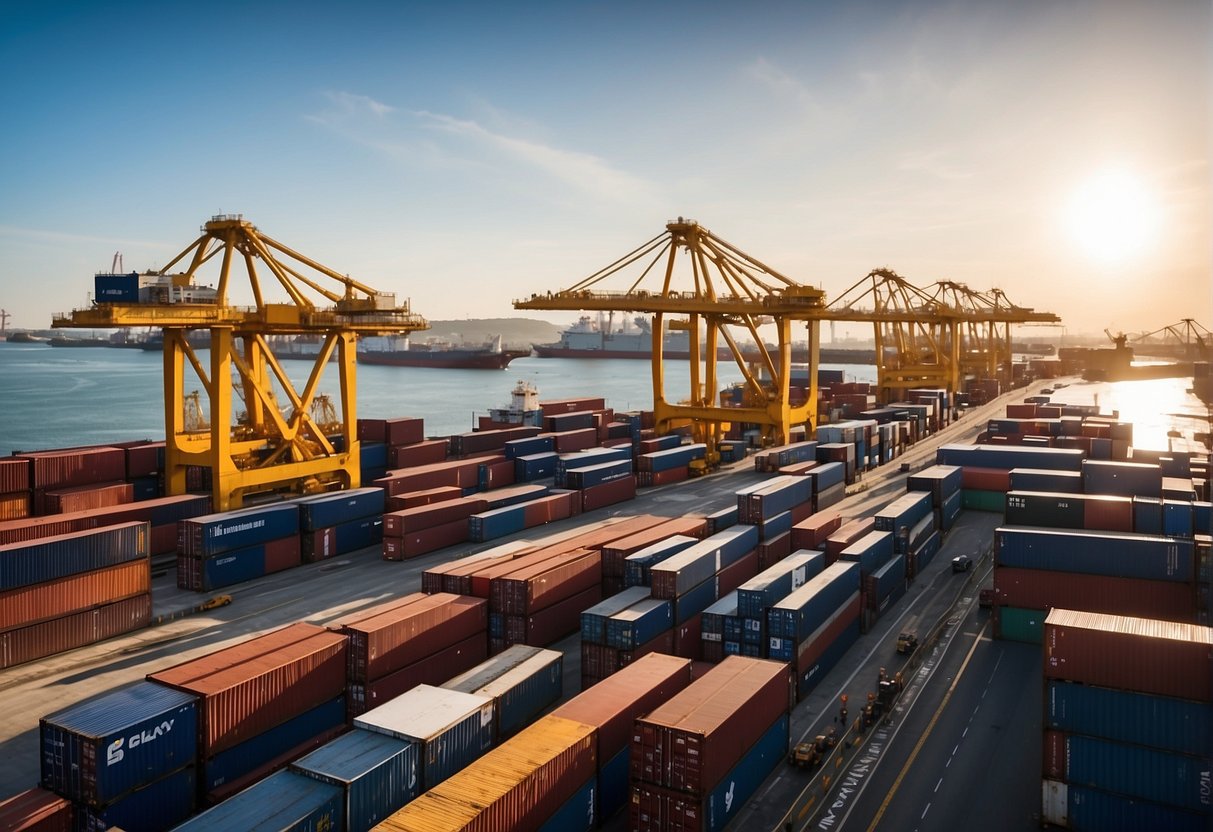How to Ship a Boat: Time, Cost, and Methods Explained
Shipping a boat can be a complex process, involving many factors to consider such as time, cost, and the method of transportation. Boat owners seeking to transport their vessel to a new destination must carefully evaluate these elements and choose the best solution that meets their needs.
The cost of shipping a boat can range from $600 to $1,000 for short distance transport, and $1,500 to $15,000 for longer hauls, depending on factors like the size of the boat and location of pick-up and delivery (uShip Shipping Guides). In addition to the cost, shipping methods also come into play, as each method has its own set of advantages and challenges. Some common methods include overland, overseas, airfreight, and lift-on/lift-off shipping (A-1 Auto Transport, Inc.).
Given the many factors that contribute to the process of shipping a boat, owners must research their options thoroughly to ensure a smooth and efficient transport experience. It is important for boat owners to weigh the pros and cons of different shipping methods and to choose a reputable shipping company that can handle their specific needs.
| BOAT BEAM WIDTH | COST PER MILE | AVERAGE COST PER MILE |
|---|---|---|
| 9 feet | $1.50 - $2.75 | $2.15 |
| 10 feet | $2.00 - $3.00 | $2.50 |
| 11 feet | $2.40 - $3.30 | $2.80 |
| 12 feet | $2.60 - $3.65 | $3.10 |
| 12+ feet | $2.75 - $3.75 | $3.25 |

Understanding the Shipping Process
Shipping a boat involves several key steps and can be done using various methods depending on factors such as the boat's size, destination, and the owner's preferences. It is important to have a clear understanding of the process to ensure a smooth and efficient experience.
The first step in shipping a boat is to choose a reliable boat shipping company. Researching different providers and their services, comparing quotes, and reading reviews is essential in making an informed decision. Factors you should consider when choosing a shipping company include their experience, reputation, and the types of shipping methods they offer (A-1 Auto Transport).
Once you have chosen a shipping company, the next step is to prepare your boat for transport. This involves proper measurement and documentation of the boat's dimensions and weight, ensuring its secure and safe packaging, and obtaining any required permits. Additionally, some shipping companies may offer shrink-wrapping services as an extra level of protection during the transportation process (uShip Shipping Guides).
There are several methods for transporting boats, and the choice will depend on factors such as the boat's size and the distance to be covered. Some common methods include:
- Overland boat shipping: This method involves shipping the boat using specialized trailers, suitable for domestic transport.
- Roll-on/Roll-off (Ro-Ro) shipping: In this method, the boat is rolled onto a vessel specifically designed for wheeled cargo and then rolled off at the destination port.
- Lift-on/lift-off (Lo-Lo) shipping: This method uses cranes to load and unload the boat onto and off the transport vessel (A-1 Auto Transport).
The cost of shipping a boat can vary significantly depending on factors such as the boat's size, the distance to be covered, and the chosen shipping method. The cost to ship a boat can be looked up here (uShip Shipping Guides).
Understanding the shipping process and the available options will help you make the best decision for your boat's transportation needs, ensuring its safe and timely arrival at the desired destination.

Time Factors
Distance and Location
One of the key factors affecting the time it takes to ship a boat is the distance between the origin and destination points. In general, longer distances will result in longer shipping times. Additionally, the location of the origin and destination points can also play a role, as remote or hard-to-reach areas may require additional time for logistics and transportation. For example:
- Express shipping typically takes 1-3 days
- Air freight takes about 5-10 days
- Ocean freight can vary between 20-45 days or more
Seasonal Demand
Seasonal demand can also impact the time it takes to ship a boat. During certain times of the year, such as peak boating season, there may be higher demand for boat shipping services, resulting in longer transit times. It's essential to plan ahead and make shipping arrangements well in advance during these peak periods to ensure timely delivery.
Customs Clearance
When shipping a boat internationally, customs clearance can add additional time to the shipping process. Depending on the country's import regulations and required documentation, this process can be relatively quick or take an extended period. It's important to work closely with your boat shipping company to ensure all necessary paperwork is completed and submitted on time to prevent delays.

Cost Factors
When shipping a boat, various factors contribute to the overall cost. Understanding these factors can help you make an informed decision when selecting a boat shipping service.
Size and Weight
The size and weight of your boat play a significant role in determining the cost of shipping. Larger boats typically require specialized equipment, permits, and escorts, which can increase the overall expense. According to uShip, the average cost to ship a boat (trailer), is around $600 to $1,000 for longer hauls and $150 to $350 for shorter distances. These figures can vary depending on the specific dimensions and weight of your boat.
Insurance
Insurance is another essential factor to consider when shipping a boat. Your chosen carrier's coverage will protect your vessel during transport, but it's crucial to verify their policy limits and exclusions. Additionally, obtaining supplementary insurance may be necessary to cover any potential gaps in the carrier's coverage. The cost of insurance will vary based on your boat's value and the extent of the coverage you choose.
Additional Services
Some boat owners may require additional services when shipping their vessels, which can also impact the overall cost. These services may include:
- Preparation and packing: Ensuring your boat is adequately prepped for transport by securing or removing loose items, draining fuel and water, and disconnecting power cables.
- Loading and unloading: Professional assistance may be necessary to safely load and unload your boat at the pickup and delivery points.
- Storage: Temporary storage options may be needed if the boat cannot be immediately delivered to its destination or if you're unable to receive it upon arrival.
Keep in mind that these services may come at an additional cost, which should be factored into your overall boat shipping budget.

Shipping Methods
When planning to ship a boat, it is essential to consider the various shipping methods available, as each comes with its advantages and disadvantages.
Overland Transport
Overland transport is an effective option for short to moderate distances. It involves moving the boat using specialized trailers to accommodate the vessel's size and weight. Be mindful of height restrictions when moving a boat on the road, as anything taller than 13 feet, 6 inches will require extra preparation, such as removing towers, arches, or pulpits to meet these height requirements (boats.com). The cost of overland transport largely depends on the distance and size of the boat being shipped.
● Greater than twelve feet long: $2.75 - $3.75 per mile
● Twelve feet long: $2.50 - $3.50 per mile
● Eleven feet long: $2.25 - $3.25 per mile
● Ten feet long: $2 - $3 per mile
● Nine feet long: $1.75 - $2.75 per mile
● Smaller than nine feet long: $1.50 - $2.50
Marine Freight
Marine freight is a preferred method for shipping boats internationally or across long distances. One common approach is liner shipping, which offers various types and advantages for transporting cargo overseas, such as break bulk shipments (Yacht World). The cost of marine freight services can vary based on the type of service, the size of the vessel, and the distance to be covered.
Roll-On/Roll-Off Ships
Roll-on/roll-off (RoRo) shipping is another option, which involves loading the boat onto a trailer and securing the vessel to the ship's deck for transport. Typically used for larger shipping vessels, this method ensures the safe transportation of the boat (A-1 Auto Transport, Inc.).
In conclusion, when considering how to ship a boat, weigh the advantages and disadvantages of each shipping method to determine the best option for your needs. Keep in mind factors such as distance, cost, and the size of your boat when making your decision.
Choosing a Shipping Company
When planning to ship a boat, selecting the right shipping company is crucial for a smooth and successful process. There are several factors to consider when making this decision, such as experience and reputation, customer service, and pricing and quotes.
Experience and Reputation
One of the most important aspects to consider when selecting a boat shipping company is their experience and reputation in the industry. A company with a proven track record of successfully shipping boats similar to yours is more likely to deliver your boat safely and on time. To assess the reputation of a company, you may want to look for online reviews or testimonials from previous customers. Furthermore, you can check if they have any relevant industry certifications that demonstrate their commitment to quality service.
Customer Service
Excellent customer service is essential in the boat shipping process, as it ensures that you stay informed throughout every step of the journey. A reliable shipping company will be easy to contact and responsive to your inquiries. They should also provide regular updates on the status of your shipment and be proactive in addressing any potential issues that may arise. YachtWorld suggests that good communication between the shipping company and the boat owner is vital to a successful boat transport experience.
Pricing and Quotes
When choosing a boat shipping company, it is important to obtain accurate pricing and quotes so that you can make an informed decision. Each company may have different pricing models based on factors such as distance, boat size, and shipping method. According to uShip, the cost to ship a boat can range from $150 to $350 for shorter distance transport and $600 to $1,000 for longer hauls. It is essential to obtain quotes from multiple shipping companies to compare and find the best option for your specific needs. Remember to ask about any additional fees that may not be included in the initial quote, such allowing for permits and escort services for larger boats.
In conclusion, when choosing a boat shipping company, take the time to consider their experience and reputation, customer service, and pricing and quotes before making a decision. By carefully evaluating these factors, you can ensure a successful and stress-free boat shipping process.

Preparing Your Boat
Inspecting and Documenting
Before shipping your boat, it's crucial to thoroughly inspect it, both inside and outside. Look for any signs of damage and take close-up pictures from all angles, making sure your camera has the date and time feature enabled. Also, snap distance pictures to capture the entire boat from various angles(wideload shipping). This will provide a clear reference in case any damages occur during transportation.
Securing Loose Items
Clean the boat's interior and remove all personal items. Only factory-installed parts should remain in the vessel during transportation(TGAL). Drain any water tanks and ensure all hatches are securely closed
If your boat has elements such as a tower, arch, pulpit, or bridge that extends above 13 feet, six inches when on its trailer, remove and safely secure them to the boat with padding for protection(boats.com). Disconnect battery terminals and remove all fuel from tanks, as required by law(wideload shipping).
Crossing Borders
When shipping your boat internationally or across state borders, ensure that you have all required documentation and permits. Each country and state may have specific rules and regulations governing boat transportation, so it's vital to check the requirements ahead of time.
It's also important to work with reliable shipping companies that have experience transporting boats both domestically and internationally. They can help you navigate the complexities of boat shipping and provide valuable guidance throughout the process.
Charlie is Editor-in-Chief of Sea Magazine







